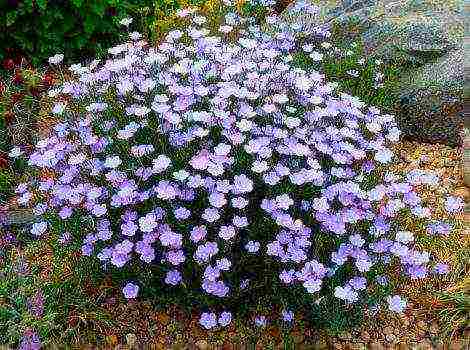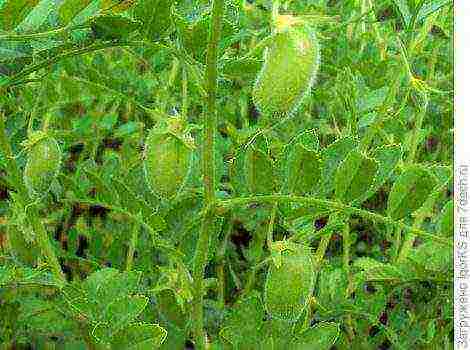Content [show]
Lemon - a tree of the genus Citrus, everyone knows its fruit. The homeland of this plant is China, India and the Pacific tropical islands.
Lemon was first introduced by the Arabs to the Middle East, North Africa, Spain and Italy.
Is it possible to grow a lemon from a seed at home?
People know about the benefits of lemon firsthand. Lemon is an excellent remedy for many ailments... It strengthens the immune system, normalizes hormones, improves vision, and stimulates the digestive tract.
It is used for colds, as it contains a huge amount of vitamin C and many people just like the sour, aromatic taste.
It is possible to grow lemon at home. If you cut a lemon, you can see a lot of seeds. It is quite possible to grow a full-fledged lemon tree from these seeds.
To a man who decided to plant a lemon at home, it is important to consider the following rules:
- the fruit should be yellow, the most ripe, since if the lemon is green, then due to the fact that it is not ripe, the germs of sprouts in the seeds of such a lemon may not sprout;
- for planting, it is important to choose several large seeds - from 10 to 15 pieces, so that later you can choose a beautiful and actively growing seedling;
- it is important to choose a suitable variety that will grow well at home.
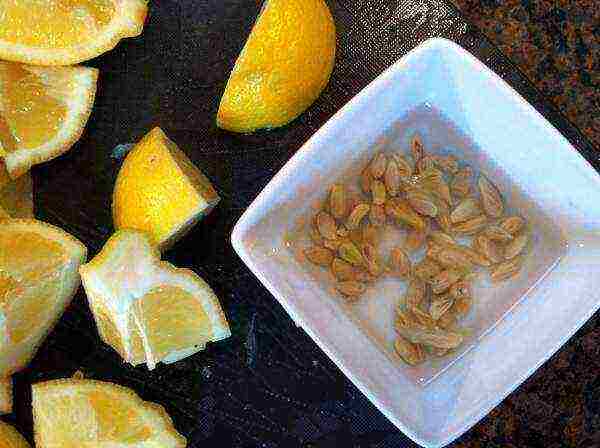 For cultivation, you must choose the right variety of lemon, the fruit must be ripe, the seeds are large
For cultivation, you must choose the right variety of lemon, the fruit must be ripe, the seeds are large
Suitable variety for a house or apartment: Pavlovsky, Meyer and others
There are many varieties. Below are some of them that are suitable for growing in a house or apartment:
- Pavlovsky - differs from other varieties in its large fruits, which can reach 500 grams, has a sweetish taste, and the tree of this variety is quite large - more than 2 meters. This variety is distinguished by fragrant leaves. The scent is so sharp and strong that the whole house will be filled with it.
- Meyer - a hybrid of lemon with grapefruit, has a sweet and sour taste, a small tree with a rich harvest, the size of one lemon can reach 150 grams, blooms in bunches, there is a seasonal dormant period.
- Ponderosa - a hybrid of lemon with grapefruit, has a bitter taste, as well as the presence of a large number of seeds. Pleases that it constantly blooms. According to the people who grow this type of lemon, it is a very grateful plant and quite unpretentious.
- Genoa - an average tree, gives a large yield already for 4-5 years of life. Fruits with delicate pulp, have a sour, aromatic taste. You can also eat the rind. This variety is considered not whimsical. For 2-3 years, the seedling is already blooming.
- Anniversary - a medium-sized tree, considered a variety that gives a rich harvest, the fruit is distinguished by its thick skin. Very suitable for growing in a house or apartment.
After the stage of selecting the variety has been passed, it is necessary to proceed to the very planting of the seeds in the pot.
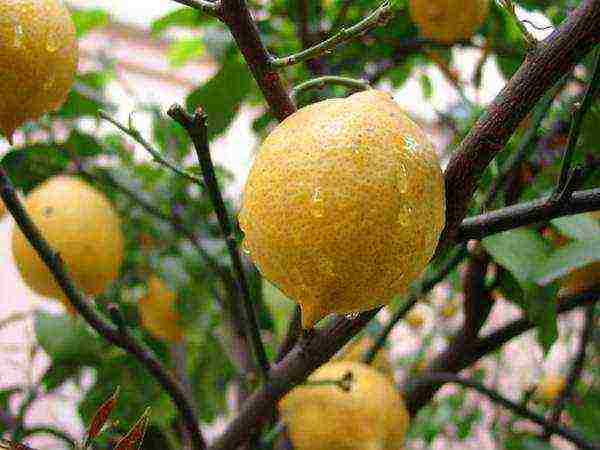 Varieties that are suitable for growing in a house or apartment: Pavlovsky, Meyer, Genoa, Yubileiny, Ponderoza
Varieties that are suitable for growing in a house or apartment: Pavlovsky, Meyer, Genoa, Yubileiny, Ponderoza
How to plant plant seeds: highlights
Some active citrus growers with a wealth of experience it is advised to free the bone from the upper husk, which in their opinion allows you to get seedlings in the shortest possible time.
This must be done very carefully, since any damage to the seed can lead to the fact that the germination of the seed does not occur.
But you can plant bones without the above procedure.
Lemon seeds must be wet before planting... It is advisable to soak them for a day in water or in a solution of sodium humate. You can buy this growth stimulant at any botanical store.
But even if the seeds were planted without soaking, and as soon as they were removed from the lemon, they will most likely sprout.
Next, you need to find a suitable small, shallow pot or glass, pour earth into it. There should be holes in the bottom of the pots... They are important so that excess moisture, due to which the roots of the sprouts may die, flows down.
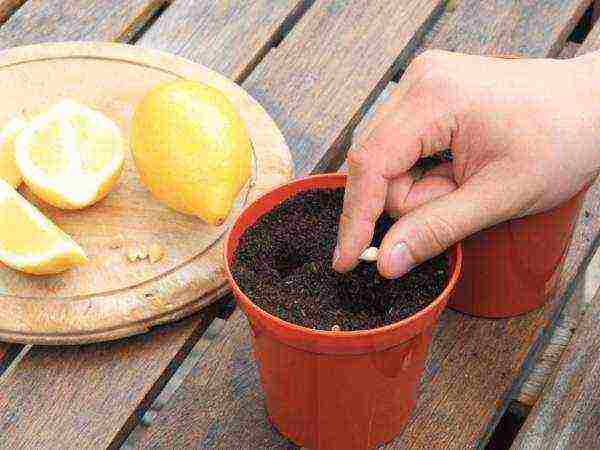 Make holes in the bottom of the pot, fill with small pebbles, soil
Make holes in the bottom of the pot, fill with small pebbles, soil
Put 1.5-2 cm of expanded clay, small pebbles or very coarse sand on the bottom of the pot. Planting soil can be purchased at the store, but you can prepare yourself. To do this, you need to mix garden soil, sand, humus and a little charcoal.
It is better to plant bones to a depth of no more than 1.5-2 cm... It is important to moisten the soil before planting. It should not be dry, but excessive moisture is also undesirable.
The pot can be covered with plastic wrap. The air temperature in the room where the seed pot is located should be above + 18 ℃.
Spray the soil once every 2-3 days... If the ground has become completely dry, then you can water it a little. After the first shoots appear, the film must be removed.
It is better to rearrange the pot with sprouts in a bright place and water with settled or rain water, at room temperature.
The first shoots will sprout no earlier than 3-4 weeks after planting.
According to experienced citrus growers, the best time to plant lemon is late winter, early spring... Since the increasing daylight hours will only benefit the young sprouts that have appeared.
Will the indoor lemon tree bear fruit?
Many people think that growing a lemon from a seed is a thankless job. Since it will take 5, 7, or even all 15 years to wait for fruits from such a lemon, and its fruits will be small in size.
For that, in order not to wait for decades when the lemon tree begins to bear fruit, it must be grafted... This can be done in two ways during the warm season (summer or warm spring):
- Into the cleft - the preferred type of grafting. It is necessary to take a stalk of a cultivated fruiting lemon. A branch is cut on the seedling, and the remaining stem of the seedling is split. A "wedge" is sharpened on the cutting of a fruiting lemon, which is then introduced into the split in the stem. Next, you need to tie the vaccine with electrical tape. 2-4 buds are left on the cutting of a fruiting lemon, everything else is cut off. The inoculation is covered with a plastic bag. When the vaccine has healed, the bag can be removed.
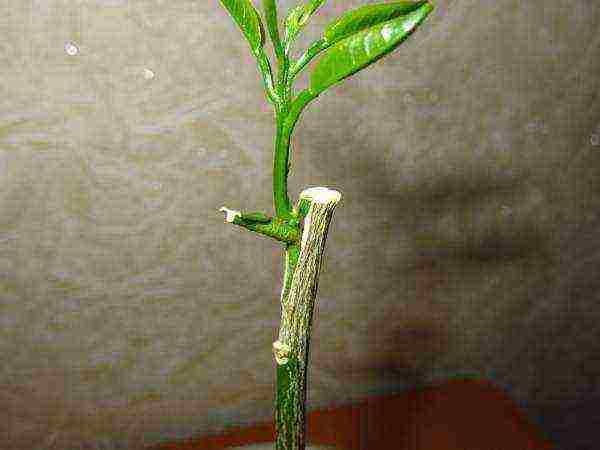 Lemon grafting - by budding or splitting - is necessary for early fruiting
Lemon grafting - by budding or splitting - is necessary for early fruiting
- Oculated - the shoots are cut off from the seedling, a "stump" 10 cm high remains from the tree.Next, take a sprig of cultivated fruiting lemon. Under each leaf of the twig is the so-called "dormant bud". A slice must be made in front of this kidney. Next, cut off the leaf plate, but leave its petiole. Cut the bark on the "stump" of the seedling and insert the petiole with the cut down. Tie the vaccination site with electrical tape. The stalk of the cut leaf plate will serve as an indicator. If the petiole falls off after 2-3 days, then we can assume that the vaccination was successful, but if it dries up, then the vaccination has failed and must be repeated.
I wonder what grown lemon from seed adapts to home conditions faster and better, it is less picky than grafted and grafted seedlings.
Why lemon grown from seed does not bear fruit:
Optimal growing conditions, care after planting
It is advisable to be very attentive to a lemon that has risen in a pot. When on lemon seedlings 3-4 leaves will appear, they are transplanted into separate pots.
It is recommended to replant young lemon trees up to 2 times a year. It is advisable to do this very carefully so as not to damage the root system.
Typically, lemon can react to both extreme heat and sunlight, as well as cold and strong winds. Therefore, when changing the location of the lemon pot, it is advisable to keep this in mind.
And the best solution would be not to change the place of "residence" of the lemon. The best place for a lemon would be the south or southwest side of the apartment. In terms of temperature, lemon can tolerate temperatures from + 14 ℃ to + 27 ℃.
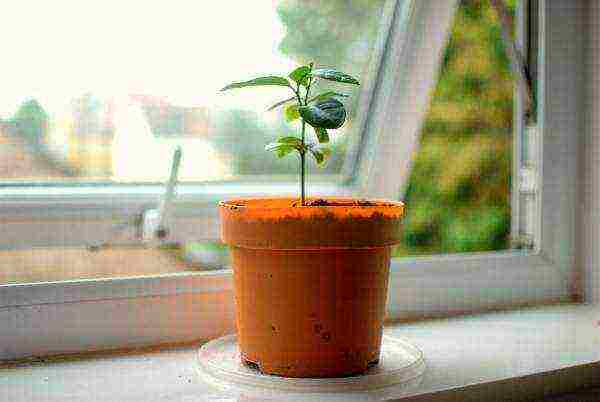 The best place for a lemon would be the south or southwest side of the apartment.
The best place for a lemon would be the south or southwest side of the apartment.
Lemon create conditions without sudden temperature jumpssince they can kill him. It is desirable to maintain a moderate air humidity of 60-70%.
Water the plant best with rainwater at room temperature. In hot summer, it is better to do this 2 times a day. And on cloudy and cold days, it is important to add lighting to lemon with LED or fluorescent lamps.
Feed in the summer a seedling can be a solution of humus and liquid mineral fertilizers.
Lemons, like all houseplants susceptible to disease and pest attacks... Therefore, they need careful care, and it is also recommended to carefully examine the plant every day in order to detect the appearance of this or that pest as early as possible and take the necessary measures in time.
Courting and Protecting: The Main Enemies of Citrus
Lemon gets sick if you do not follow the rules of care. If the tree is watered a little, it will dry out. If the soil in the pot is oversaturated with moisture, then yellow leaves will appear on the lemon, and this will be a sign that the roots of the tree are beginning to rot.
Same the appearance of yellow spots on the foliage, after which the leaves dry and fall off, indicate that the wood lacks iron.
Drying leaf ends say that the tree needs phosphorus. And the lack of potassium and manganese leads to wrinkling of the leaves and falling off of the ovary.
Knowing how to grow a tree is not enough; it is important to be able to care for it. If a pest is seen on the plant, it is necessary to figure out what kind of parasite it is and urgently take measures to combat it.
Below are some common parasites that can attack a home-grown lemon:
- Mealybugs, popularly known as "hairy lice" - on a tree they can be recognized by a white bloom. They prefer dry conditions, they are afraid of moisture. A good prevention of this parasite will be regular washing of all lemon leaves.
- Shield - small shiny droplets appear on the leaves, sticky to the touch. Leaves dry and fall off. Soapy or garlic water is used against this pest. Soap water is prepared as follows: 2 tablespoons of liquid soap are dissolved in 1 liter of water. The resulting mixture is treated with the affected tree. An hour after the procedure, they are washed under the shower.It is desirable to repeat the treatment after 2 days.
- Spider mite - small, light dots on the sheet plate. The leaves are curling up. A cobweb is visualized on their back. If this parasite is found on the lemon, it is necessary to treat the tree with sulfur. For prevention purposes, the lemon is washed under running water, paying more attention to the underside of the leaf plates of the tree. Spraying with a solution of water and laundry soap helps to fight the mite well.
 Common parasites that can attack home-grown lemon: mealybugs, scale insects, spider mites
Common parasites that can attack home-grown lemon: mealybugs, scale insects, spider mites
Prevention measures
There are several simple preventive measures that will prevent the attack of parasites or damage to the tree by diseases:
- give a lemon tree a hot shower... The plant will not suffer from this, and unnoticed parasites will be neutralized and washed away;
- spray the leaves (especially from the bottom side);
- wipe the lemon leaves once a week with soapy water (it is better to use laundry soap).
"Fitosporin" is considered a good remedy for many diseases and pests. It is non-toxic and odorless. It can also be used well as a preventive measure.
The lemon tree is not geranium, it needs proper care and it is very difficult for a beginner to figure out what, how and when to do it.
With the effort and study of the rules for caring for lemon, you can get a pleasant result. Home-grown lemon will delight not only with its aroma, but also with delicious fruits.
Growing lemon from seed:
 Many types of citrus fruits grow well at home. But how to grow a lemon from a seed, which would not only decorate the room with leathery dark green foliage, but also bear fruit?
Many types of citrus fruits grow well at home. But how to grow a lemon from a seed, which would not only decorate the room with leathery dark green foliage, but also bear fruit?
It is the absence of ovaries on grown plants that often disappoints home citrus growers. Indeed, in the best case, from the moment of planting to the flowering of an indoor lemon, it takes from 4 to 7 years. And yet, getting a lemon from a seed is an exciting and not a futile exercise. A strong tree can be used as a rootstock by grafting a stalk of a cultivated specimen on it, or push it to fruiting with competent care and crown shaping.
Preparing seeds for growing lemon
If you are going to grow a lemon from a seed at home, you need to be patient and have some knowledge.
The main mistake of indoor plant lovers who have failed in growing lemon or other citrus fruits is that they used seeds that had been extracted from the fruit long ago and that had time to dry out for sowing.
It is much more correct to remove the seeds from ripe fresh lemons, rinse them with warm water and embed them in the substrate immediately, without drying. This will greatly increase the number of seedlings.
Experienced citrus growers recommend another way to increase the speed and quality of germination. To do this, wet lemon seeds intended for growing at home are carefully freed from the hard surface shell with a sharp knife, which is the main obstacle to the sprout hidden in the seed.
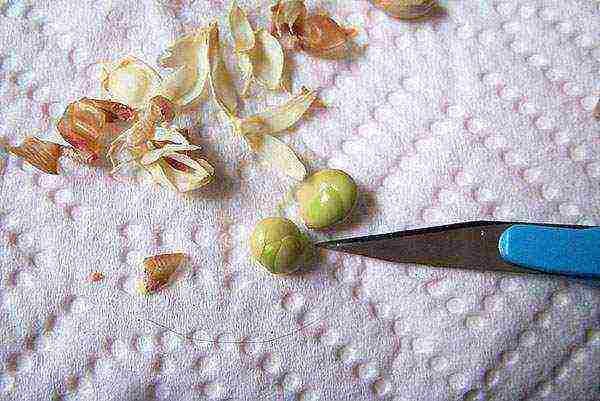 Following this advice, you need to be extremely careful and careful. Wrong movement threatens to damage the cotyledons or a delicate embryo, and then the lemon will definitely not appear from the seed.
Following this advice, you need to be extremely careful and careful. Wrong movement threatens to damage the cotyledons or a delicate embryo, and then the lemon will definitely not appear from the seed.
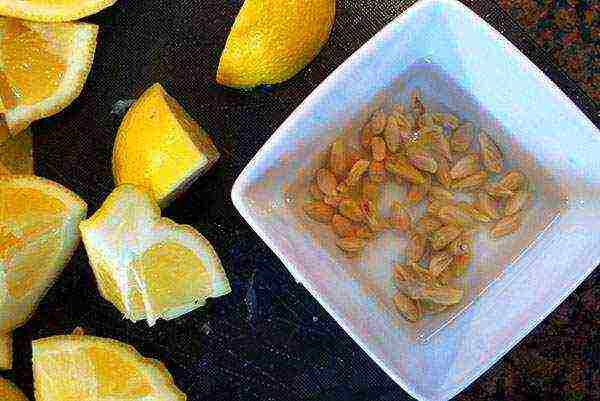 If lemon seeds remain in the shell, it is useful to immerse them in a growth stimulant solution for several hours, preventing the surface of the seeds from drying out between processing and planting.
If lemon seeds remain in the shell, it is useful to immerse them in a growth stimulant solution for several hours, preventing the surface of the seeds from drying out between processing and planting.
Growing lemon from seed at home
Before planting lemon seeds, choose shallow, wide containers with mandatory drainage holes. A 2-centimeter layer of fine expanded clay or vermiculite is poured onto the bottom of the pot or other container so that all excess moisture, dangerous for delicate roots, does not linger and leave the ground in time.
You can make your own soil for growing lemon from seed at home by mixing garden soil, humus and sand. It is useful to add a little crushed charcoal to such a substrate, which will reduce the risk of developing bacterial infections. If you don't have the right ingredients on hand, a ready-made citrus substrate, which is easy to buy at a specialty store, will do.
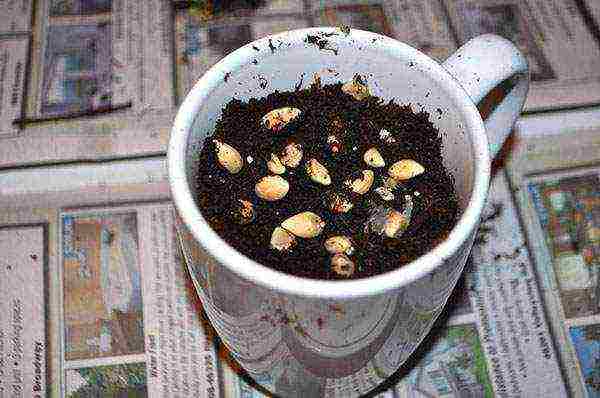 All preparatory work has been done. Now it's time to start sowing. How to grow a lemon from a seed at home?
All preparatory work has been done. Now it's time to start sowing. How to grow a lemon from a seed at home?
The best sowing time is at the end of winter. Then the sprouted sprouts will receive good support in the form of increasing daylight hours.
The seeds are buried in moist soil to a depth of about two centimeters. Several seeds can be planted in one container at once. Since the seedlings are waiting for the first transplant, when 3-4 true leaves appear on them, the plants will not interfere with each other.
The containers are determined in a greenhouse or placed in a warm place, previously covered with a bag or film. Do not forget that all citrus fruits are thermophilic, therefore, it is possible to grow a lemon from a seed at home only if a certain temperature regime is observed.
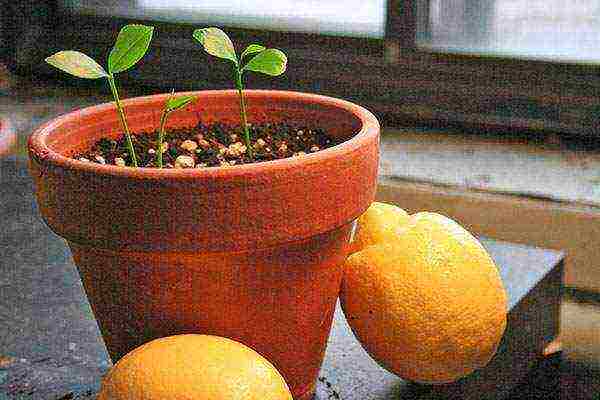 Seedlings will not start growing if the air and soil in the room are colder than +18 ° C. It is optimal if seed germination and subsequent growth takes place at a temperature of 22 to 25 ° C, with constantly high humidity, the absence of drafts and other negative factors. Compliance with simple rules on how to grow a lemon from a seed allows you to get friendly strong shoots.
Seedlings will not start growing if the air and soil in the room are colder than +18 ° C. It is optimal if seed germination and subsequent growth takes place at a temperature of 22 to 25 ° C, with constantly high humidity, the absence of drafts and other negative factors. Compliance with simple rules on how to grow a lemon from a seed allows you to get friendly strong shoots.
On average, from sowing to the moment the shoots appear, it takes from a week to a month. During this time, the soil in the pot can be carefully sprayed, but it should be watered only when there are obvious signs of drying out.
Lemon Seedling Care
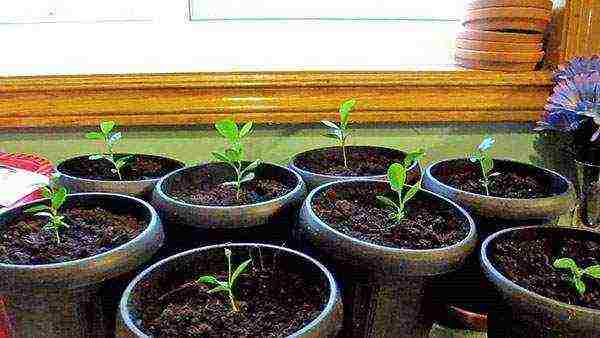 With the appearance of green shoots above the soil surface, they gradually begin to accustom them to room conditions, airing and opening the greenhouse. When 3-4 leaves appear from the seed on a young lemon, the film is removed altogether, and the seedlings are sorted and transferred to their own small pots.
With the appearance of green shoots above the soil surface, they gradually begin to accustom them to room conditions, airing and opening the greenhouse. When 3-4 leaves appear from the seed on a young lemon, the film is removed altogether, and the seedlings are sorted and transferred to their own small pots.
Since the seeds of hybrid fruits do not always carry parental characteristics, citrus growers seeking to get a lemon from the seed at home risk growing wild.
To understand how soon the tree will begin to bear fruit, and what quality the ripe fruits will be, it is already possible by external signs. First of all, cultivated citrus trees are distinguished by a small number of thorns on the shoots.
Further care in the first year of seedlings consists in timely watering, transplanting and pinching for the initial formation of the crown of the future tree. 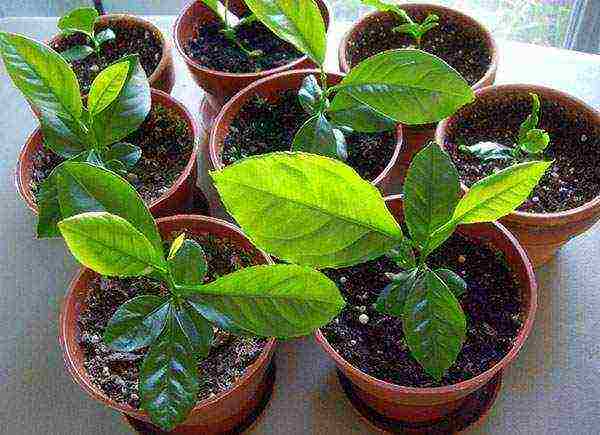 In addition, plants:
In addition, plants:
- in the summer months, after 10-14 days, they are fed by alternating a solution of humus and liquid mineral fertilizers;
- on cloudy days and in the cold season, they are additionally illuminated using fluorescent or LED phytolamps.
The duration of illumination largely affects the flowering and fruiting of plants from the tropical zone. Therefore, the purchase of such lamps should be attended to before growing a lemon from a seed.
Transplantation for young lemons is carried out annually, and the plant should be transferred very carefully, without disturbing the root system. If the roots have not yet mastered the entire earthen lump, you can do with replacing the surface layer.
 Interested in how to grow a lemon from a seed, many enthusiasts look forward to the shoots first, and then the first flowers. But in order not to weaken the plant, the lemon should not be allowed to bear fruit until it is 2-3 years old. The seed lemon ripens for flowering when there is only one flower per 15 leaves of its crown.
Interested in how to grow a lemon from a seed, many enthusiasts look forward to the shoots first, and then the first flowers. But in order not to weaken the plant, the lemon should not be allowed to bear fruit until it is 2-3 years old. The seed lemon ripens for flowering when there is only one flower per 15 leaves of its crown.
If the earlier formation of the ovary weakens the tree, then pinching at the age of about a year only contributes to the formation of the crown and will lay the foundation for future good yields.Therefore, in a very young plant, it is necessary to remove all shoots directed deep into the crown, pinch the tops of excessively long shoots, and also sometimes turn the pot with a tree so that it illuminates and develops as evenly as possible.
We grow a lemon from a stone - video
Part 1. Planting seeds
Part 2. The appearance of the first shoots
Part 3. Transplanting seedlings

Everyone sometimes wants to show off a yellow fruit grown at home. But how to grow a lemon from a seed, so that it also gives fruit, and not only grows wood? It is very easy if you follow the correct farming techniques.
How to properly grow lemon from seed
In general, propagation of lemons by cuttings is used much more often. However, they can also be grown from seeds. Healthy seedlings are easy to obtain by following a few simple citrus farming practices.
Lemons, like all citrus fruits, quickly lose their germination. We take seeds from well-ripened fruits. We extract seeds from them. Immediately after that, we sow them in a pre-prepared planting substrate. With prolonged storage, the outer shell of the seed begins to dry out and become covered with cracks. That is why germination very quickly decreases to almost zero. Therefore, we sow seeds the faster, the better, while they are still moist from the pulp of the fruit.
Video about growing lemon from seed
The soil is prepared from two parts of peat, one part of leafy soil and one part of sand. It is thoroughly mixed, loosened, moderately moisturized. Future shoots grow from one end of the seed, and roots from the other. It is important not to confuse them with the sides, so the seed sits horizontally in the soil. We lay them on the ground, cover them with one and a half centimeters of soil, moisten them, cover them so that the soil does not dry out.
Over the next four to five weeks, we monitor the crops, do not allow both drying out and waterlogging. In a little more than a month, the seeds will begin to hatch. Small lemon sprouts come to the surface. Water them carefully, trying not to wash out the topsoil. After the appearance of the fifth or sixth leaf, we dive the seedlings. Until this time, it is undesirable to touch the root system of the sprouts.
The reason is that citrus fruits have one powerful deep root. While a small sprout, the root is also small, weak. Disturbing it before 5-6 leaves are formed - you can lose our lemon seedling.

Pictured is a small lemon
During transplantation, we cut off the root, stimulating its branching. Sometimes it is convenient to do this even before transplanting; for this, the vertical root is cut to the seedlings growing in the box, without removing them from the ground. This operation is done as follows: we dip a horizontally sharp knife 10 centimeters into the soil and hold it under the sprouts. After that, to disinfect the damaged roots, we spill the plantings with a weak solution of potassium permanganate, that is, potassium permanganate. Such an operation less injures the delicate root system of lemon trees, while stimulating its branching, the formation of lateral roots.
Preparing the soil for planting lemons
So, a young lemon grown from seeds is ready for planting. We dive the seedling immediately to a permanent place. For the next year or two, it will grow in the pot that we define for it. Answering the question of how to plant a lemon from a seed, we note that, first of all, a very high-quality, properly prepared substrate is needed.
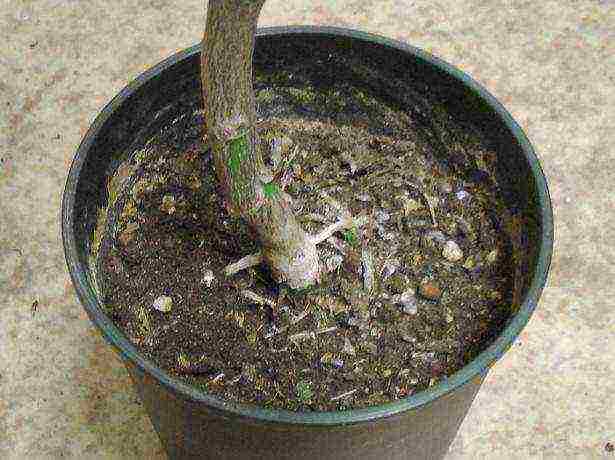
In the photo, the soil for planting lemon
Here is the recommended soil composition for lemon:
- one or two parts of birch or linden leaf humus;
- one part of manure humus;
- one part of meadow land, preferably from meadows where clover or alfalfa grows, such land is enriched with nitrogen;
- one part of calcined gray (not yellow) river sand;
- half of the wood ash, but not conifers.
Lemon is very sensitive to the presence of petroleum products in the soil.You can check your soil for cleanliness from them as follows: we dilute a handful of earth in a bucket of water. If no oily rainbow bloom appears on the surface, then the substrate is clean.
In addition, to get rid of various soil parasites that may be in your substrate, it is worth disinfecting the soil. Moreover, this operation will be useful regardless of whether you took land from the surrounding meadows and forests, or purchased potting mixes in a store. It's never harmful to play it safe.
The soil is poured into an enameled steel bucket, filled with a liter of water, put on fire. Close with a lid and wait 30-40 minutes until the mixture is well steamed. After this operation, let the soil cool and dry.

In the photo, planting a lemon
You can now fertilize the soil before planting lemon seedlings. It is best to use organic complexes containing humic acids or effective microorganisms. This will bring your sterilized soil into a natural ecological balance. Next, pour a solution of complex micronutrient fertilizers containing iron, manganese, molybdenum, selenium, zinc. We fertilize with nitrogen, potash, phosphorus fertilizers.
Later, when transplanting mature trees, the composition of the substrate is slightly modified. If the above mixture, due to its lightness, is recommended for young plants, then for older plants, the addition of loam, lake silt, peat, and an increase in the proportion of sand is characteristic.
For lemons aged 3-4 years, the following composition is recommended
- 2 hours of leaf humus;
- 4 hours of manure humus;
- 2 hours of high-moor peat;
- 1 hour river sand.
For trees from 4 to 8 years old, the following composition is suitable
- 4 parts of meadow chernozem;
- 2 hours of leaf humus;
- 2 hours of lake or river silt;
- 1 hour river sand.
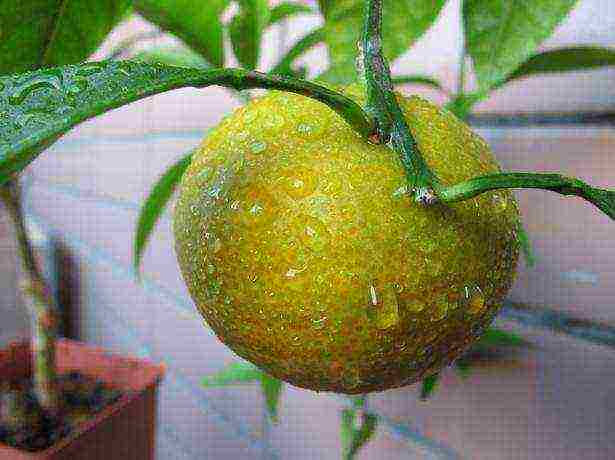
Photo of lemon
For aged lemons, over ten years old, the optimal composition of the soil is as follows
- 6 parts of meadow chernozem;
- 2 hours of leaf humus;
- 2 hours of high-moor peat;
- 4 hours of lake silt;
- 1 tsp sand;
- 0.5 hours of hardwood ash.
Planting and caring for a lemon tree
So, we have grown a seedling from a seed. Cut the vertical root and now it is ready to be planted in the main place. We cover the bottom of the pot with a layer of expanded clay 1.5-3 centimeters. We pour a layer of substrate in the form of a mound on top. Powder the lemon roots with ash, spread over the mound. Then we begin to cover it evenly with earth. Periodically tamp the soil lightly with a small stick, it is best to use a sushi stick for this purpose. This must be done to prevent the formation of air voids at the roots of the tree. We fall asleep to the level of the root collar, that is, to the place where the roots go into the trunk.
Deepen the root collar - you will get rotting of the lower part of the bark, it will begin to burst, release resin, most likely it will get sick with gommosis - a fungal disease of citrus fruits. A young seedling may even die from this.
It is very important! The root collar must not be buried.
Next, follow the growth of the lemon. In a year or two, the root system will completely fill the space of the pot. We check it as follows - turn the pot over, knock it on a hard surface. The lump should easily fall out of the pot. The bottom of the soil should be well braided with roots. So we transplant it into a container that is large in size, but not too spacious. 3-4 centimeters larger in diameter.
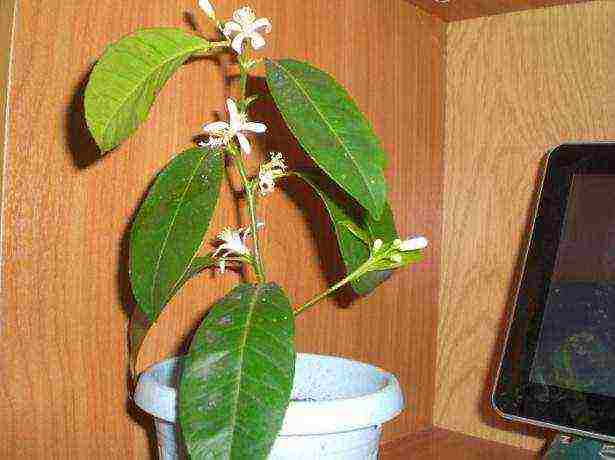
Homemade lemon tree photo
Most often, plants suffer from:
- insufficient or improper feeding;
- excessive dryness of the room air;
- dust;
- non-observance of the temperature regime.
Water the lemons often, but the soil should not be waterlogged. Feed once every two weeks with small amounts of compound fertilizers. Spray the leaves weekly with a spray bottle, sometimes clean the fox from dust with a damp sponge (in case of strong dust pollution of the room). Put your tree under the shower every month. Observe the temperature regime.Lemon should be cooler and drier in winter than in summer. This means that you need less watering, dressing. That's actually all in brief, what you need to know about the normal care of a lemon tree grown from a stone. Next, let's talk about lemon propagation by cuttings.

Photo of a watered lemon
Propagation by cuttings
Let's take a close look at some important aspects of cuttings so that the question "how to grow a lemon from a cuttings" is no longer a problem.
Here are some points to keep in mind:
- The main thing is that we take cuttings from an already fruiting tree.
- We take a stalk from a healthy, vertical branch.
- Too young (still flattened) or already lignified (should bend normally) is not suitable.
- The best time for cuttings is April.
- We use branches of last year's autumn growth.
We cut off cuttings of 2-3 buds, leaving only two or three upper leaves. We put in a solution with a root formation stimulator: heteroauxin, root, epin. We plant the cuttings, deepening them in half, in an equal mixture of light soil and calcined sand. We cover the top with a centimeter layer of sand to avoid rotting of the lower part. We cover all this with a glass jar or glass. This will prevent the moisture from evaporating from the cuttings, which is detrimental to them, until they have acquired a root system. We protect our future lemons from direct sunlight. We block them with matte paper. Or we put on the northeast or east windows. Pour water two to three degrees above room temperature. After two or three weeks, roots will begin to form. A sign of this is the appearance of new leaves. in another two weeks you can plant our seedlings. As you can see, grafting a lemon is a fairly simple operation.

Photo of lemon
The timing of the onset of fruiting lemon plants grown in various ways
We are often led to believe that it is extremely easy to get seed-grown plants to bear fruit. That regardless of whether you are the owner of a grafted plant grown from a cuttings or a tree seed, you will still get the first harvest no later than four years later. You are being deceived.
- First, the timing of the entry into fruiting of citrus fruits grown in different ways is different.
- Secondly, the mere presence of a tree at home does not imply that it will bloom at all. It requires proper care, attention, the creation of optimal conditions for fruiting, feeding, lighting, temperature, microclimate and much, much more.
The timing of the onset of fruiting in various lemons is as follows:
- seed trees bloom in 8-10 years;
- citrus fruits obtained by cuttings from a previously flowering tree will give the first fruits in 3-4 years;
- plants grafted with a layering from a fruiting tree can bloom as early as the next year after grafting;
- all these terms become irrelevant if the cutting for rooting or grafting is taken from a previously never fruiting adult plant.
Video about how to grow a lemon from a seed
If the lemon blooms and bears fruit at least once, it will do so every year with proper care.
It is also worth knowing that our acidic citrus fruits can delay their flowering if you overdo it with feeding and grooming. This is especially true for nitrogen fertilizers. Trying to provide the plant with ideal conditions, we are doing it a disservice. The lemon rushes upward, completely without thinking about laying fruit buds. Indeed, the plans of our green pet do not at all include supplying us with a crop.
The need to grow yellow fruits arises when the tree feels some threat to its comfort. Such threats activate the mechanisms of leaving offspring, that is, the harvest. What are we hindering by pampering our lemons. Such excessive care, as well as insufficient attention to the plant, lead to a shift in the timing of fruiting.To stimulate fruiting, indoor citrus only needs: regular watering with additional fertilizing during active growing season, a dormant period, a lot of sun, room humidity.
It is also sometimes recommended to ring the trunk - to remove a layer of bark 1 centimeter wide in a circle perpendicular to the soil and graft it with the back side to the cut site. There is a technique of wrapping branches with wire or similar banding, like a trunk. Please note that these methods are auxiliary, and sometimes their effectiveness is controversial.
Rate the article:
(3 votes, average: 1.7 out of 5)
Hello!
Today I want to tell you in detail how to grow a lemon from a seed at home. Yes, not just a lemon, but a real tree with fragrant and healthy fruits. Last year I wrote about growing tangerine from seed and in the comments there was a request to tell about lemon. There are some points to consider in order to drink tea with your lemons after a few years.
Growing lemon from seed at home
Lemon is an evergreen bush with glossy, fleshy leaves. On them and on the branches of the bush there are many pores that emit essential oils and phytoncides - this is a wonderful lemon scent we all know.
A lemon grows at home as a small tree, but it can be up to three meters. It has small thorns on the branches, the leaves are dark green. Lemon has beautiful small flowers - pink-red or purple on top and white on the inside.
 Lemon flower
Lemon flower
It's just that you won't surprise anyone with a lemon tree now, but a tree with fruits is not so common. But this is quite a feasible task for everyone.
Landing
Let's start from the very beginning. You need to choose the right seeds for planting and prepare the ground. We choose a beautiful, even, ripe lemon fruit. We choose the best from it - large seeds. And we plant in a wet state - there is no need to dry, otherwise they will sprout for a long time or will not germinate at all.
Before planting, you can treat the seeds with any biostimulant for quick germination and the formation of good roots in the future. To do this, prepare a solution according to the instructions for the preparation - and soak the seeds overnight.
It is necessary to prepare containers for sowing and good soil. You can buy seedling pots at the store or use yogurt or sour cream cups for this, cut off plastic bottles. At the bottom you need to make holes and put drainage. It can be shards from pots, nut shells, pebbles, a layer of vermiculite up to 1.5 cm.
Plant a lot of lemon seeds at once - a couple of dozen at once. Firstly, not everyone will grow, and secondly, you will have the opportunity to choose the best ones for further cultivation, and finally, not everyone can tolerate the vaccination well.
Maybe it will seem to someone that the information about the holes in the cups, about the need for drainage is known to everyone and there is no need to write about it in such detail. But I remember myself as a novice gardener and I did not always know all the intricacies of planting and care. And the plants died.
Now you need to prepare loose, fertile soil. Planting lemons in commercial citrus soil or making your own is no problem. We mix humus, leafy earth in equal amounts and add peat and sand for ease. We moisten the earth and lay out the bones in pots. We plant the seeds to a depth of about 2 cm.
The temperature for germination of lemon pits must be at least 18 ° C. To create the best conditions for the lemons to germinate and develop, cover them with cut-off plastic bottles. Or just cover the seed cups with foil and put them in a warm place. This will create the conditions for a greenhouse for lemons.
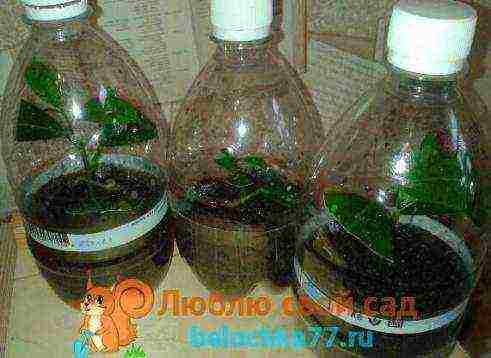 Lemons under plastic bottles - mini greenhouse
Lemons under plastic bottles - mini greenhouse
You do not need to fill in the seeds after sowing - they can suffocate and mold. It is better not to water at all, but simply spray the ground with a spray bottle.Water only when the ground begins to crack. And after the emergence of lemon shoots, it is also better to observe the low watering regime so that the roots do not rot.
Growing lemon from seed at home
Sprouts appear in an apartment in different ways. It can take from two weeks to a month. Until 4 leaves appear, young seedlings are kept in mini-greenhouses. We gradually accustom the seedlings to room air - we spray them more often. Then we rearrange the pot in a bright place, but without direct sunlight, otherwise the young sprout will die.
Do not forget about watering, in the sense that do not get carried away
Water the seedlings only after the soil is dry.
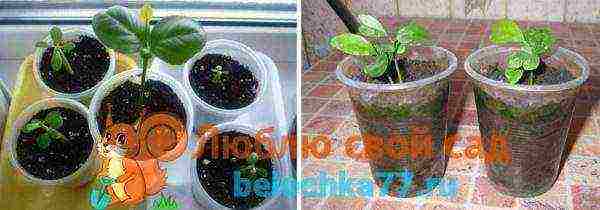 The first shoots and small seedlings of lemon
The first shoots and small seedlings of lemon
Helpful hints:
- Use water at room temperature. Rain and melt water is good for irrigation - just not cold.
- A small lemon is not fed in the first months. In spring and summer, you need to water with biofertilizer. But always remember that underfeeding is better than overfeeding.
- Don't forget that the lemon tree is a moody and demanding plant when grown indoors. It likes constant temperature or humidity. Abrupt changes in climate and care will immediately reflect a deterioration in the health of the lemon.
- Hot, dry climate, exposure to direct sunlight, drafts and cooling of the air, wind - these factors can lead to the loss of all leaves and death of the plant.
- By autumn, watering is completely reduced, only after the earth dries up is the land lump moistened. Be sure to make sure that the water does not stagnate, and the excess flows freely. They are fed in the fall once a month.
- Already in the first year of growth, the seedling begins to form its crown. Remove all deformed, inward growing weak branches.
Growing lemon at home in a pot
When there are 2-3 true leaves on the seedlings, the strongest are chosen and transplanted into pots. For lemon, it is best to grow only in clay pots. The diameter and depth increase as the tree grows. A few hours before transplanting, the pot must be soaked in water. Be sure to put a drainage layer on the bottom. You can cover the hole with a crock, with the convex side facing up. Pour small shards, pebbles, coarse sand, coal, expanded clay on top.
We fill in the soil the same as was prepared when planting lemon seeds. After transplanting, cover the seedlings with a jar or half a bottle again. We remove it only after the seedling has completely taken root. At the same time, new leaves will begin to grow.
How to choose the best seedlings for transplanting... Here are the main things to look out for:
- We look at the density of the crown. See the distance between the buds on the seedling - take with the smallest ones.
- The presence of needles. Less is better.
- The quality of the leaves. There are many of them, hold on tightly, do not fall off from the touch.
- All weak, thin shoots with bad leaves are immediately rejected.
Lemon tree - care rules and growing problems
Growing lemons at home requires special care. If you follow all the rules, you can get flowering and fruiting plants.
- For lemon, additional lighting is needed - especially in early spring and autumn.
- A humid climate must be created in the room. To do this, spray the plant more often. Give him a shower, wash the leaves - lemons are tropical inhabitants and love high humidity.
- Frequent transplants are important for a young lemon. We prepare the earth as for the first landing. Plants are necessarily transplanted with a clod of earth. They take a new pot 5-7 cm more. Young ones - once a year, an adult plant can be transplanted every 2-3 years. The best time in summer is in June, and in winter we transplant in February.
- In the period from February to September, lemon grows more actively - therefore, you need to feed the bushes with biofertilizers at this time, alternating with mineral fertilizers. We feed only with liquid fertilizers. Let's not forget the rule: less is better than more.
- We form plants correctly.To make the tree more luxuriant and actively grow lateral shoots - pinch the top of the head. Better to do this in the first year of growth.
- For proper crown formation, the pot should be turned a quarter every week. In the future, a well-formed trunk will affect the quality of the fruit.
- If the lemon at home began to bloom in the first year, then you need to cut off all the flowers - do not regret it. Lemon spend all its energy on flowers and then wither away. Lemon can be allowed to bloom when the plant has at least 15 leaves per flower!
Will seed-grown lemon bear fruit
Full-fledged fruit plants grow from the seeds, but they begin to bear fruit late. Seedlings grown from seeds are more adaptable to home conditions. They are more hardy than cuttings.
In order for the lemon to start bearing its first fruits early, you can graft it with other citrus fruits. For example:
tangerine
, grapefruit. The optimal time for this operation is early summer or spring.
Another important factor is the formation of the crown. As I already wrote, in the first year they pinch the top of the head - more precisely, when the seedling grows to 20 cm.Then branches of the second order begin to grow, they are pinched when they grow 18 cm.Further, the process is repeated until the branches of the 4th order appear - the first flowers and fruits appear on them ...
 Fruiting lemon at home
Fruiting lemon at home
And yet, before flowering, the lemon needs to rest. To do this, in the winter, put it in a cool place for several months. And in the spring, put it in a warm, bright place.
Types of indoor lemon
Many varieties can be grown at home - these are Pavlovsky, Maikop, Eureka, Genoa, Meyer, Novogruzinsky. The most productive is Maykop. Genoa and Eureka varieties are not tall and can grow even on a warm windowsill.
Lemon variety Pavlovsky
 Pavlovsky lemon
Pavlovsky lemon
This is an old variety of folk selection. Bred in the village of Pavlovo more than 100 years ago. The variety is very unpretentious, well adapted to home conditions - dry air and insufficient lighting.
Pavlovsky lemon
grows up to 2 meters. The crown is round. It can give from 20 to 40 fruits per year. Begins to bear fruit for 4 years.
Meyer lemon variety
 Meyer lemon variety
Meyer lemon variety
It appeared in Russia in 1929. It became widespread in Europe, as it gave rich harvests in the open field. It is considered a natural hybrid of lemon and orange.
Lemon Chinese
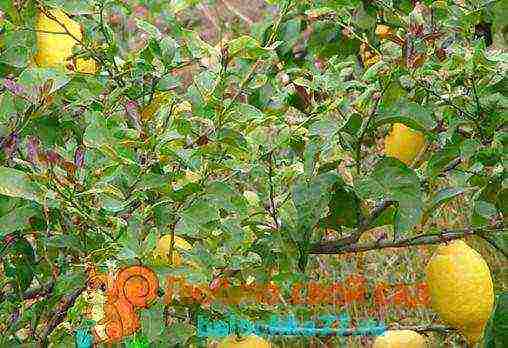 Lemon Chinese
Lemon Chinese
This is a short tree - usually about a meter. Differs in high productivity. Begins to bear fruit early - for 2-3 years. Fruits are early ripening, blooms on old and young shoots, blooms early.
Shades poorly - must be grown on the south and southwest windows. It tolerates heat well, but during the dormant period, the leaves need coolness and moisture.
Lemon variety Jubilee
 Lemon variety Jubilee
Lemon variety Jubilee
Unpretentious, productive, decorative variety. Grows up to 1.5 meters. It blooms very profusely - it looks like a white ball from the abundance of flowers. Fruits weighing 500 grams with a thick, yellow skin. Begins to bear fruit in the 2nd year of life. Shade-tolerant, grows quickly and adapts well to different conditions. The fruits are tied in any conditions.
Genoa lemon variety
 Genoa lemon variety
Genoa lemon variety
This variety can be from 1 to 3 meters long, without thorns. Begins to bear fruit at 4-5 years. Usually about 50 fruits are harvested per year. On an adult tree, up to 100 pieces. It blooms several times a year, genoa lemons are medium-sized up to 100-120 gr. Differs in high palatability of fruits.
Lemon variety Maikop
 Lemon variety Maikop
Lemon variety Maikop
The variety is common for growing at home, as it is very unpretentious and fruitful. It tolerates cold well. The mass of lemons is 120-160 gr., 200-300 fruits are harvested per year. Trees at the age of 30 give 700 fruits a year. Branches without thorns.
Lemon variety Novogruzinsky
 Lemon variety Novogruziskiy
Lemon variety Novogruziskiy
Tall tree up to 3 meters. Begins to bear fruit for 4-5 years.The fruits are very fragrant, with a thin crust, without seeds. With good care, it produces up to 200 fruits per year.
How to plant lemon at home
The best way is the graft vaccination. I suggest watching a video on how to carry out this operation.
Indoor lemon pests and diseases
The most common pests of lemons at home are scale insects, aphids, spider mites, and scale insects. All of them suck sap from plants, leading to curvature of shoots, drying of leaves.
With all pests, there are general rules for the fight to save the lemon:
- Brush off insects from twigs with a soft toothbrush. It can be removed from the leaves with a cotton swab. We wet the instruments in a soapy solution of anabasine sulfate.
- After a day, we wash off the solution from the plant. After a week, we repeat the treatment.
- In case of severe pest damage, we process the bushes with infusions of onions, garlic, celandine, tobacco. Or we use drugs Actellik, Fitoverm (biological product). Use chemicals very carefully at home - these are strong poisons.
 Lemon diseases
Lemon diseases
The main diseases of all citrus fruits at home are sooty fungus and gommosis. From the fungus, the leaves become covered with a gray coating, in which their nutrition is disturbed. And with homoz, gum appears at the sites of damage to the bark - the branches and leaves gradually dry out.
Actions for diseases:
- We clean the bark or the place of the disease - we process it with vitriol (copper).
- We cover it with RanNet (or garden varnish).
- Wipe the leaves with the fungus with a wet cloth.
- We feed with fertilizers to maintain the strength of the plant to fight the disease.
How and in what quantities to use drugs for plant treatment or pest control can always be read on the packaging of each drug. You will find a large number of them in any specialty store.
Growing lemon in a greenhouse
As stated earlier, the lemon tree loves:
- Strong but diffused light
- Good root breathing
- Constant freezing temperatures all year round
All these conditions can be observed in the best way in conditions: greenhouses, loggias or balconies with glazing, in a greenhouse or conservatory.
Growing lemons and other citrus fruits in a greenhouse has its own characteristics. You can plant lemons directly in the ground or in pots. For cultivation in soil, the greenhouse must be heated.
Let's take a closer look at the requirements for the greenhouse in which the lemon will grow:
- A prerequisite is that even in severe frosts, the temperature should not fall below + 6 ° С, but preferably + 10 ° С.
- A lot of diffused light is needed. In the autumn-winter period, you need to use additional lighting, and in the spring and summer, on the contrary, shade from direct sunlight.
- Remember that lemons do not tolerate stagnant air, with high humidity - you need to ventilate the greenhouse. But don't create drafts!
In an apartment, the most suitable place for planting and growing lemon is a glazed and insulated balcony or loggia.
Otherwise, the cultivation and care of plants is completely the same as described in the article.
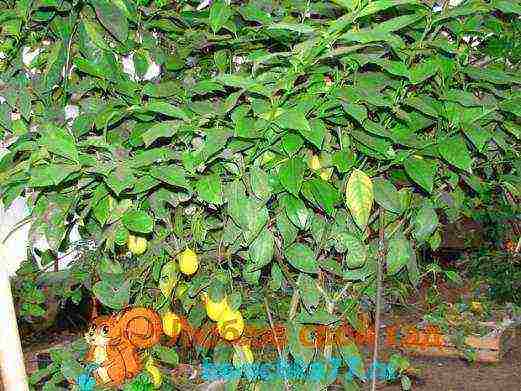 Lemon in the greenhouse
Lemon in the greenhouse
I will repeat the main points that are important for obtaining full-fledged seedlings:
- Choosing beautiful fruits
- We sow freshly harvested wet seeds - do not dry!
- Water gently as the soil dries
- Cover the pots with plastic wrap or bottles - create a mini greenhouse.
- When applying fertilizers, remember the rule: it is better to underfeed than overfeed.
- We form and transplant young lemons on time
Plant and grow lemons with pleasure!
This is where I end. How to grow a lemon from a seed is now no secret for you. If you have any questions or comments - write in the comments.
Best regards, Sophia Guseva.
Other interesting articles:
- Growing a tangerine from a bone
- Marigolds - planting and care. Photo of flowers
- How to grow gladioli outdoors
- Types of roses with photos and descriptions
- How to plant mango from seed

